RockShox Reverb AXS B1
Lengths Available: 100 mm, 125 mm, 150 mm, 175 mm, 200 mm, 225 mm, and 250 mm
Diameters Available: 30.9 mm, 31.6 mm, 34.9 mm
Blister’s Measured Weights:
- Reverb AXS post: 740 g (30.9 x 225 mm, with battery)
- AXS Pod Controller: 58 g (with Rocker paddle, discrete clamp, and battery)
MSRP:
- Seatpost: $549 USD
- AXS Pod Controller: $150 USD
Mounted To: Transition Repeater EP8
Reviewer: 6’, 160 lb / 183 cm, 72.6 kg
Test Locations: Washington
Test Duration: 4 months
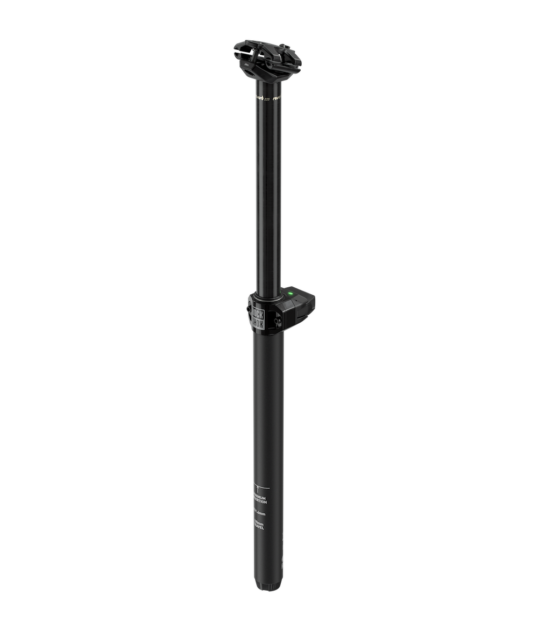
Intro
The RockShox Reverb AXS opened the floodgates to electronics on mountain bikes when it was released back in 2019 alongside Eagle AXS. It addressed some of the reliability issues of prior Reverb designs, too, but as droppers started getting more and more drop, the Reverb AXS started to feel a bit outdated with its maximum 170 mm of travel.
SRAM has been busy with new releases this year, and the updated Reverb AXS B1 is officially here, too. It addresses the travel limitations of the old one by going as high as 250 mm of drop, but it also brings a novel internal design with an air-over-air layout rather than a more conventional oil-filled cartridge. In addition to simplified internals, the design brings something that SRAM calls ActiveRide — as the post moves into its travel, the seatpost can move under the rider’s weight to absorb bumps.
It’s a big update, so let’s unpack the changes below — and keep reading further for our Full Review after several months on the trail with the new Reverb AXS B1.
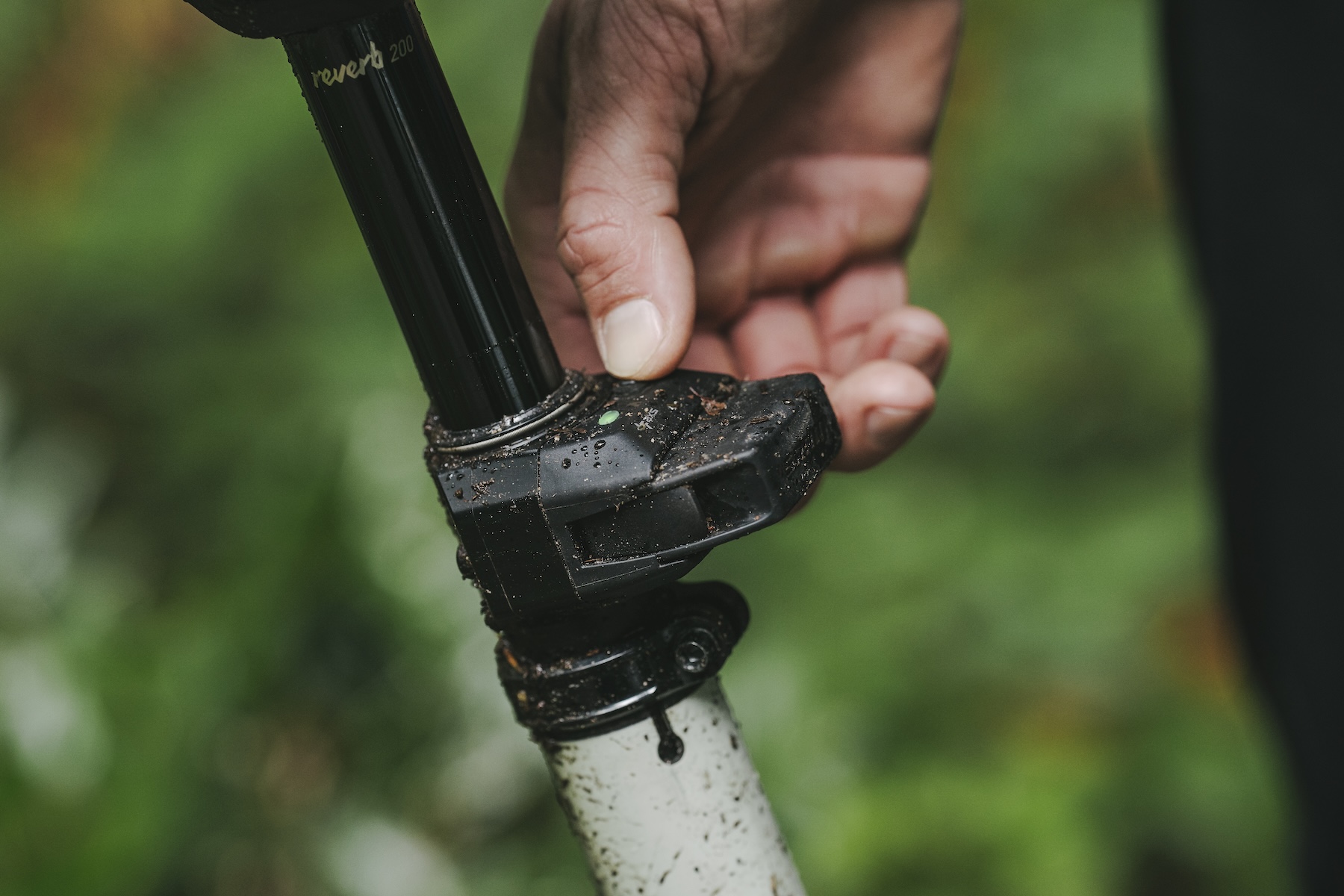
Design
Starting with the general layout of the new Reverb AXS B1, it’s immediately clear that a lot has changed in the new one. Compared to the original, the new Reverb AXS adopts a more traditional two-bolt seat clamp assembly, moving the electronics module and battery to just below the seal head (much like Fox’s Transfer Neo). The simpler seat clamp accommodates both round and oval rails and should do away with the slipping issues that could come up on the older style seat clamp, too. RockShox has also vastly expanded the range of travel options available, ranging from 100 mm to 250 mm in 25 mm increments, and the new Reverb AXS is available in 30.9 mm, 31.6 mm, and 34.9 mm diameters.
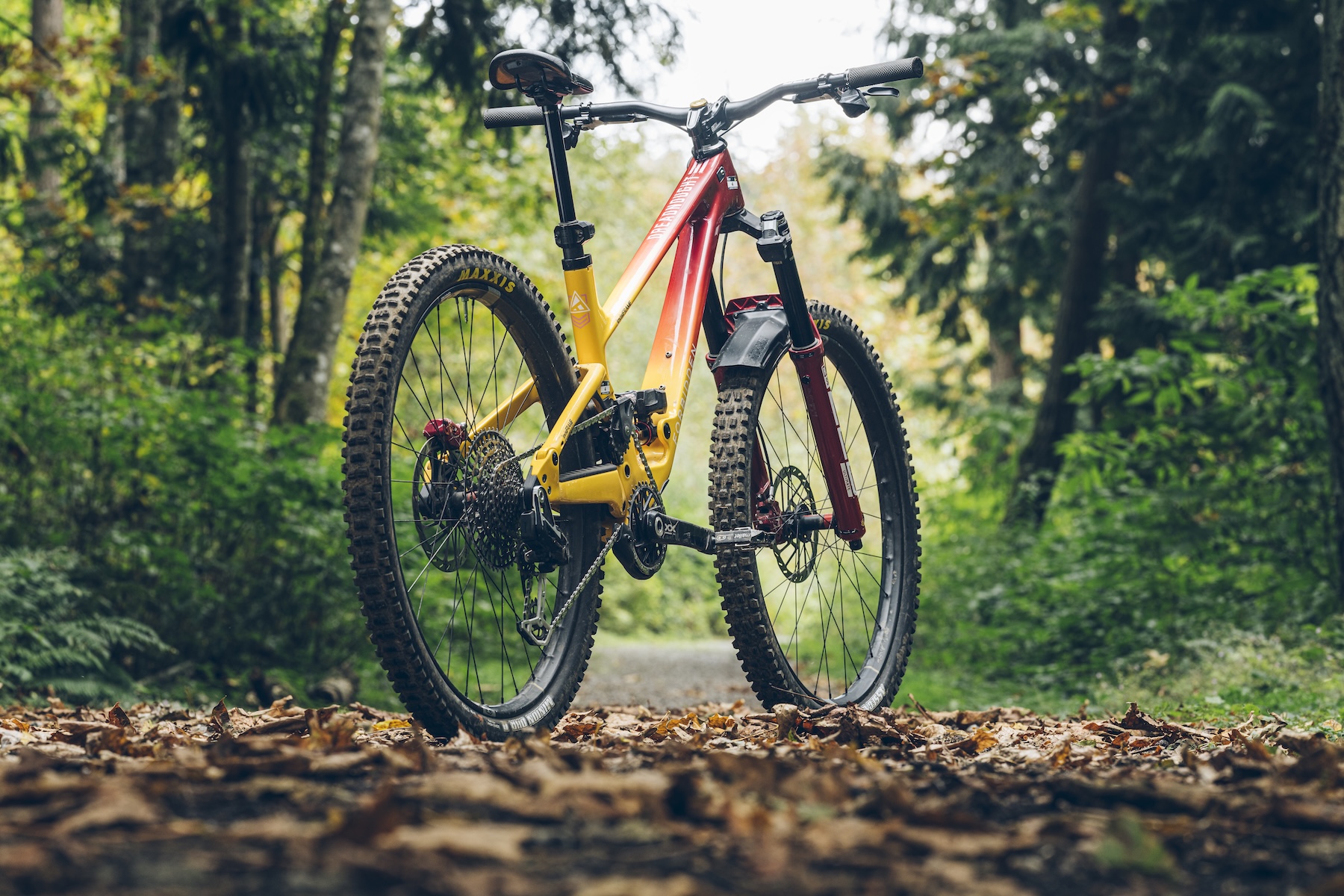
Unsurprisingly, the battery is the same AXS battery used across all of SRAM’s AXS-powered components. The electronics module now sits at the bottom of the post rather than in the post head, and RockShox says that the new battery placement allows for a simpler design that doesn’t require special tools for disassembly. The battery mount takes up a good bit of real estate around the seal head, increasing stack height over a mechanical post. RockShox’s press release doesn’t state the exact number, but I measured it at about 62 mm on our 30.9 x 225 mm sample — just a few millimeters shorter than the 65 mm stack height of the original Reverb AXS (measured from bottom of the collar to center of seat rails, with post lowered). That means it’s still a good bit taller than the 47 mm stack height of the Fox Transfer Neo, and more than twice the stack height of the OneUp V3.
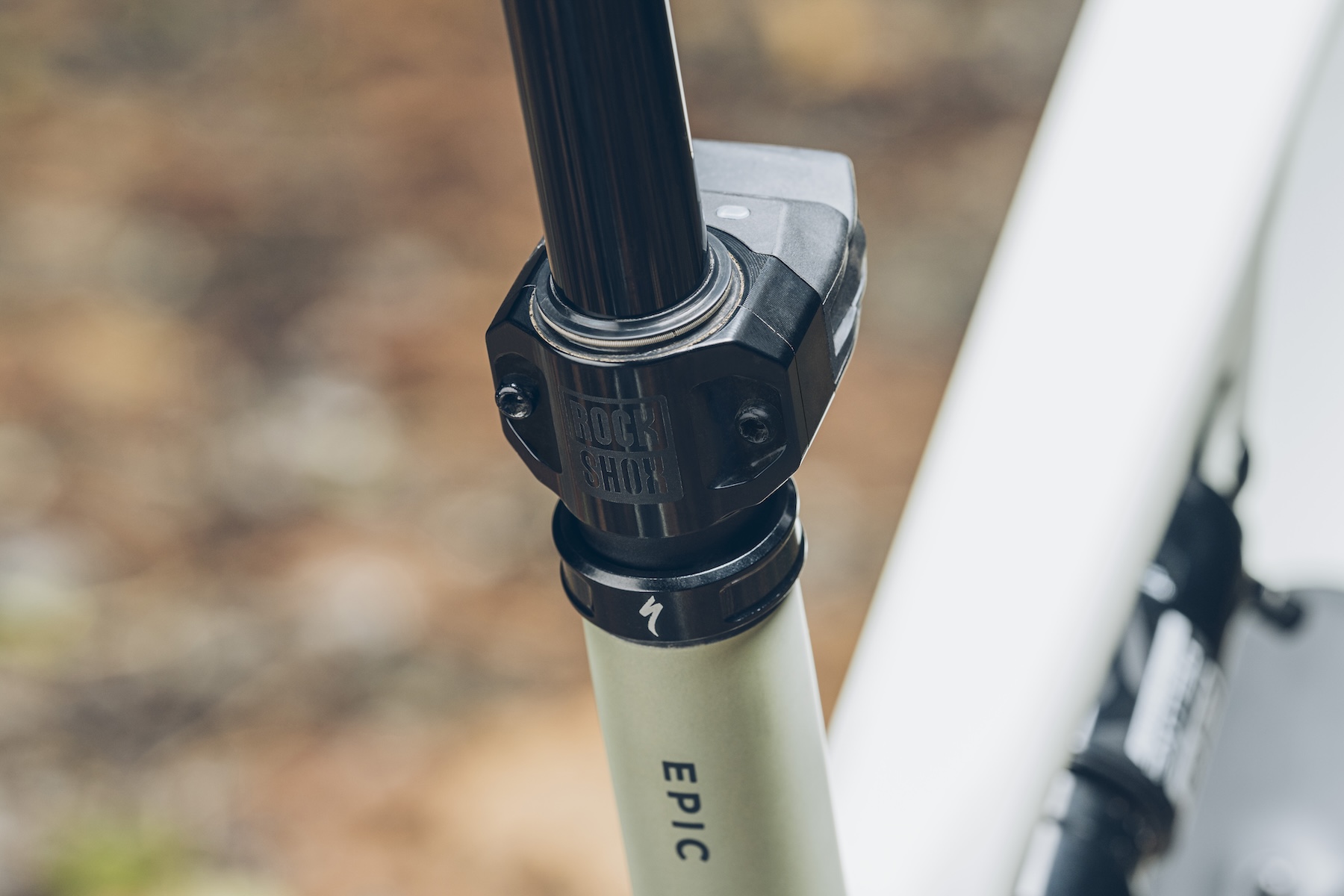
There are some very big changes inside of the Reverb AXS, too. Rather than your typical oil-filled cartridge with an air-backed IFP, the Reverb AXS uses an entirely air-based cartridge design. The design’s goal is to minimize the number of parts and increase durability — and as you can see in the graphic below, the number of internal parts is quite small.
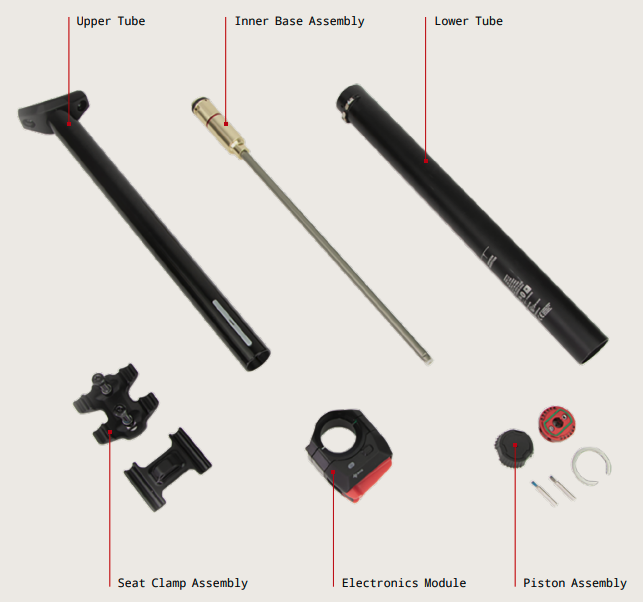
Part of what allows a more conventional dropper post cartridge to stay firm at a given height is the use of oil, which is very good at resisting compression but loses that ability once air makes its way into the cartridge. By using an air-only spring design, RockShox doesn’t have to worry about keeping air and oil separate within a cartridge, but it does mean that the seatpost doesn’t remain totally rigid once lowered from topout. In this case, though, RockShox doesn’t seem to think that extra bit of give is a bad thing — and they’re calling it ActiveRide.
Some folks may recall the suspension seatposts that were semi-common in the late 90s and early 2000s, and some readers may have noticed their slight resurgence amongst the Gravel community. ActiveRide basically brings a similar suspension element to the new Reverb AXS. When the seatpost is at topout, there’s virtually no negative air spring volume in play, and the post is rigid. As the post is lowered, the negative chamber volume increases, allowing the post to compress slightly under the rider’s weight. RockShox touts ActiveRide as helping with comfort while seated in technical terrain, especially on steep, punchy climbs.
RockShox also claims that the simpler air-only cartridge simplifies service. There are relatively few parts and no oil-filled cartridges to bleed — RockShox says a basic service is advised every 300 hours of riding (or once a year), and RockShox sells 600-hour (or two-year) complete service kits. While the service doesn’t require true specialty tools for disassembly, it does require some vise blocks and a high-pressure shock pump. The 30.9 mm and 31.6 mm diameter posts have a minimum air pressure of 400 psi and a maximum of 600 psi, while the larger diameter 34.9 mm model drops to a 225 psi minimum and 335 psi max. All posts ship at their maximum recommended pressure, but adjusting pressures will require a high-pressure pump, sold separately.
FULL REVIEW
The original RockShox Reverb AXS was the first wireless dropper post to reach widespread popularity, but had started to fall behind the competition, mostly in its limited maximum drop of 170 mm. The new Reverb AXS B1 cranked things up massively in that regard, but also arrived with a fully redesigned architecture. We’ve been logging a lot of hours on this latest dropper from RockShox, and it’s proven to be a marked improvement over the original — but it still isn’t perfect. Read on for our Full Review after four months of ride time.
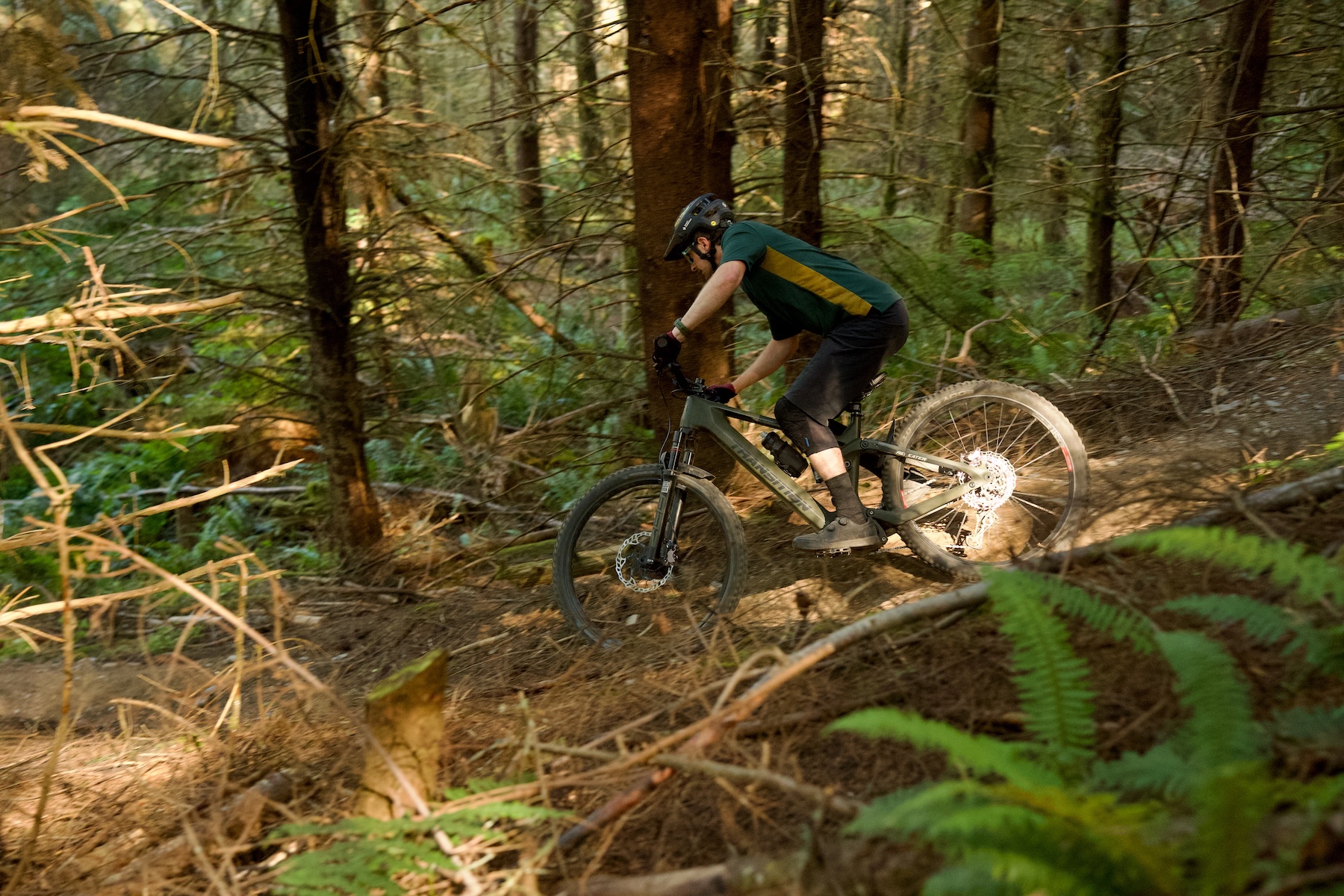
On-Trail Performance
One of the biggest areas of competition in the dropper post market is in compressed stack height, or the distance from the bottom of the seal head assembly to the center of the saddle rails with the dropper compressed. It’s a measurement that manufacturers can try to minimize as a way of allowing for more drop at a given saddle height — every millimeter shaved from stack height is another millimeter that could theoretically be added to the amount of available drop while keeping saddle height the same.
This is a particular challenge for electronic droppers because of the battery and electronics. Both the Fox Transfer Neo and now the RockShox Reverb B1 place their electronics and battery housing at the post’s seal head, inherently adding to the stack height over mechanical posts that don’t require a large electronics assembly in that area. I talked about this in my Flash Review, but this is where the Reverb AXS B1 falls short for me. The Reverb AXS B1’s 62 mm stack height is quite tall — it’s a good bit taller than the 47 mm stack height of the Fox Transfer Neo, let alone the 30 mm stack height of a 31.6 mm diameter OneUp V3 post. While slightly shorter than the older Reverb AXS’s 65 mm stack height, I would have liked to see a shorter measurement here to increase compatibility and maximum drop options for more riders.
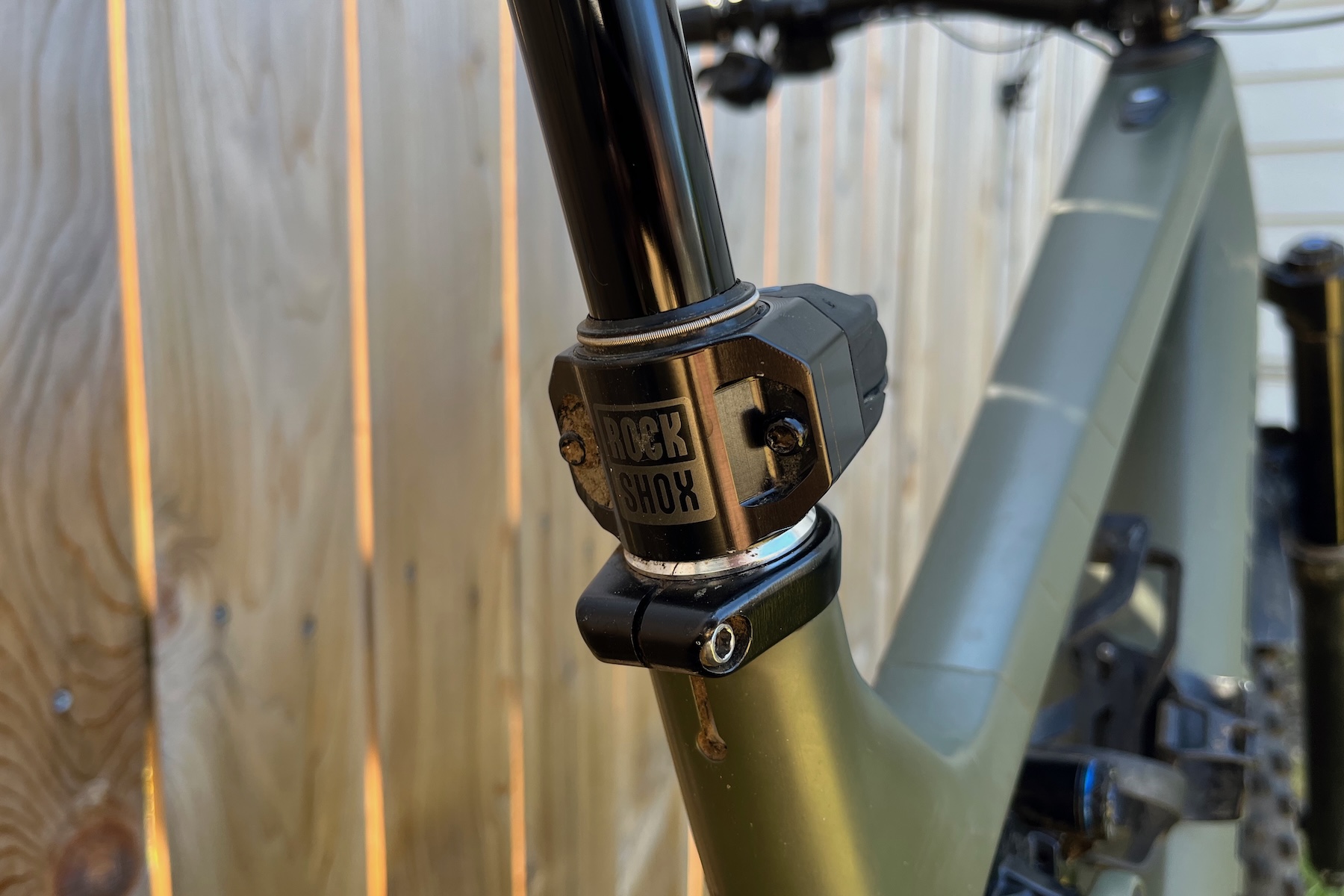

That said, I was able to cram the 225 mm drop Reverb AXS B1 into my size Large Transition Repeater EP8, but just barely. That’s a huge drop by most standards, and while it’s not as long as a 240 mm drop OneUp V3 post I tried a while back, it still feels gargantuan even compared to my typical 200 and 210 mm drop posts.
With my stack rant out of the way, let’s move on to how it actually performs. Fortunately, I don’t have much to say here, as the Reverb AXS B1 worked without fault throughout testing. The post arrived at the maximum air pressure of 600 psi (which is terrifyingly high on paper), and I ended up leaving it there throughout the test as I found the return speed to be quick without feeling so fast as to threaten my nether regions.
The ActiveRide “feature” feels like more of a product of the air-only cartridge design rather than something I would seek out, but I really didn’t mind the extra few millimeters of compliance either. To reiterate from the Design section above, the extra sag of ActiveRide only exists when the post is between fully extended and fully lowered. It can add some comfort on really chunky extended climbs, but otherwise largely goes unnoticed. I see that as a good thing, particularly given that it’s a byproduct of the new air-only cartridge that has so far seemed quite reliable, especially compared to the outgoing Reverb and Reverb AXS designs.

David Golay: I’ve also spent a bit of time on the new Reverb AXS, and I’ll just echo what Zack said there: the little bit of movement in the post feels more like a byproduct of the air-only cartridge design than it really is a feature, but the effect is also quite subtle in most real-world on-trail scenarios. I was somewhat skeptical when I first heard about the design, but quickly stopped thinking about it once I got the Reverb AXS on dirt.
Zack: As another small note, I also really like the addition of the standard two-bolt seatpost head. The battery life is also great, requiring only a few charging sessions over four months of frequent use. I still don’t love having to charge a battery, but on a bike like my Repeater, which unfortunately uses headset cable routing, I’ll happily charge the battery every few weeks if I don’t have to snake a cable through the abomination that is that bike’s cable routing.
With my stack rant out of the way, let’s move on to how it actually performs. Fortunately, I don’t have much to say here, as the Reverb AXS B1 worked without fault throughout testing. The post arrived at the maximum air pressure of 600 psi (which is terrifyingly high on paper), and I ended up leaving it there throughout the test as I found the return speed to be quick without feeling so fast as to threaten my nether regions.
The ActiveRide “feature” feels like more of a product of the air-only cartridge design rather than something I would seek out, but I really didn’t mind the extra few millimeters of compliance either. To reiterate from the Design section above, the extra sag of ActiveRide only exists when the post is between fully extended and fully lowered. It can add some comfort on really chunky extended climbs, but otherwise largely goes unnoticed. I see that as a good thing, particularly given that it’s a byproduct of the new air-only cartridge that has so far seemed quite reliable, especially compared to the outgoing Reverb and Reverb AXS designs.

Durability
The prior generation RockShox Reverb and Reverb AXS posts were often (and deservedly, in my experience) bemoaned for their poor reliability and fussy maintenance. RockShox clearly invested a lot of time in addressing those concerns, going so far as to design a novel air-only system for the Reverb AXS B1 that doesn’t rely on an oil-filled cartridge, and so far it seems to have paid off. I usually found that prior Reverb posts were inclined to develop some sag over the course of a few months, and that’s not the case here.
The Reverb AXS B1 also held its air pressure very well throughout the test, which is good, because my one maintenance complaint is the fact that the post uses such ridiculously high air pressure as to require a special high-pressure pump. RockShox doesn’t include one, meaning that it’s a supplemental purchase that really only serves the need of occasionally topping up the Reverb AXS B1’s air pressure.
I did notice the Reverb AXS B1 slowing down a bit on occasion, but it was usually due to a dust-filled wiper seal. A quick cleaning seemed to restore everything to its proper speed and smoothness. RockShox says that the post only needs a basic service every 300 hours (or 1 year), and a complete service is required at 600 hours (or 2 years), though, as with other droppers, I find that performance can be maintained with more regular attention to quickly cleaning up and lubricating the seal head. All service manuals are available on the SRAM website.
Finally, even if I still don’t like the ergonomics of the Pod remote, I never had issues with it losing connection to the post or having communication hiccups.

Bottom Line
In my mind, the best thing that a dropper post can do on the trail is to go unnoticed. Throughout testing, that’s been how I would describe the RockShox Reverb AXS B1 — after four months and hundreds of miles of use, it continues to do just what it’s supposed to without a complaint. A shorter stack height would help more riders take advantage of the longer drop options now offered, and I don’t love the ultra-high inflation pressures requiring a special pump, but reliability and consistency are key in the dropper game, and the Reverb AXS B1 delivers those in spades.
